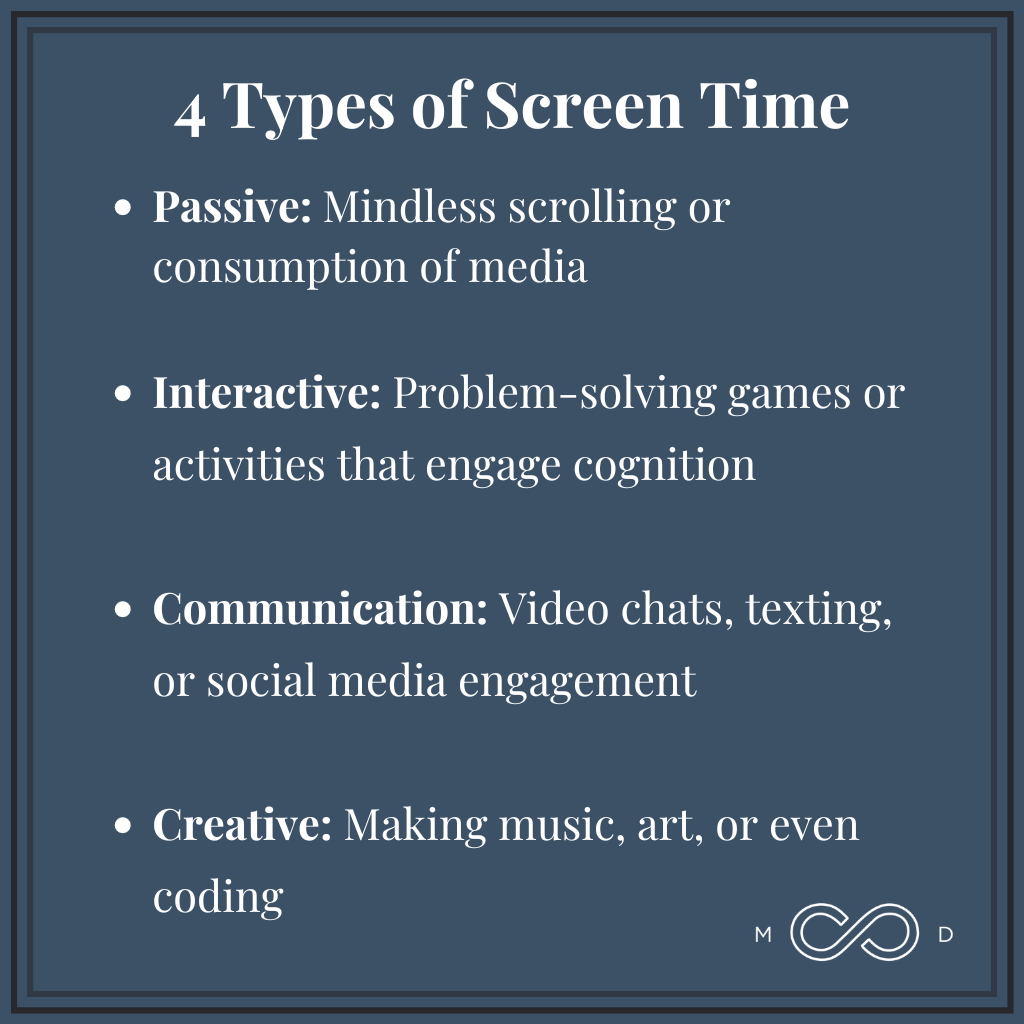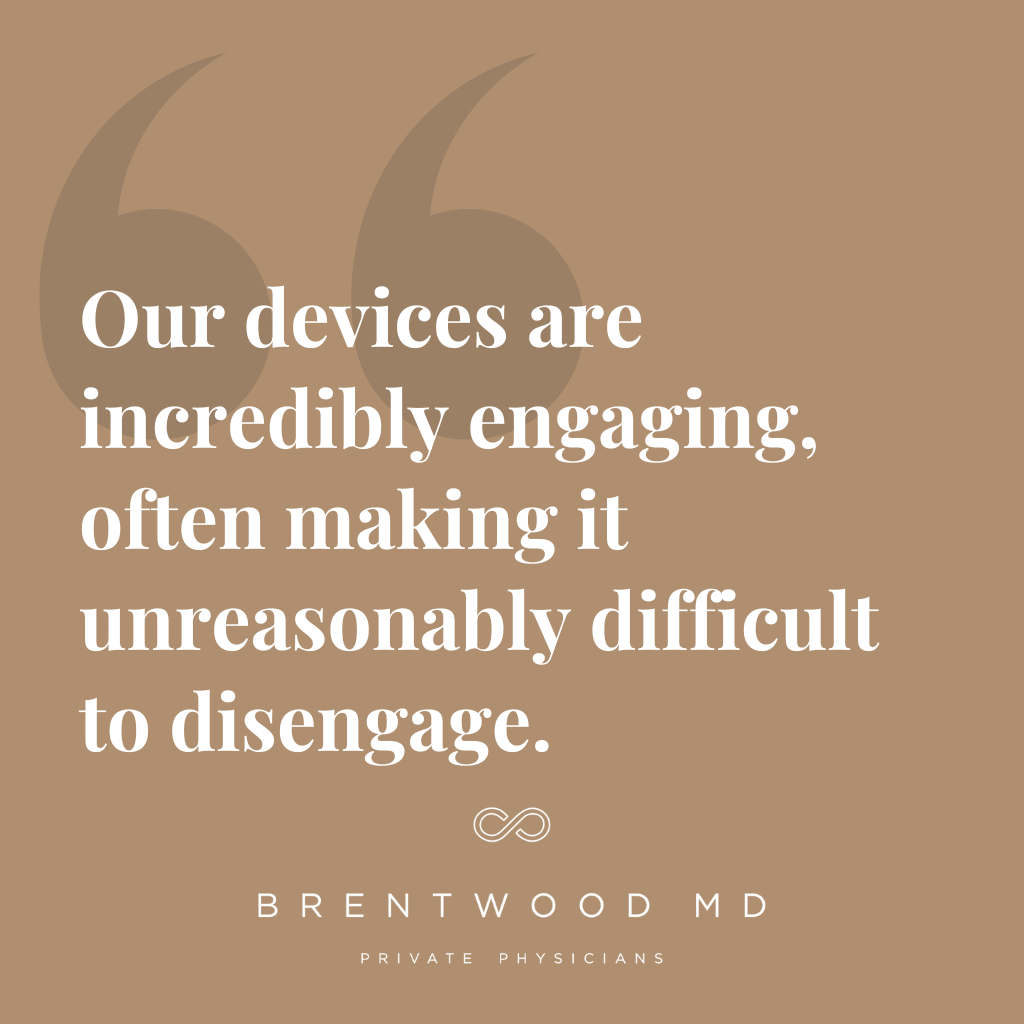As a physician, I often find myself in the challenging position of advising patients about healthy lifestyles while grappling with my own habits.
Just this week, I caught myself telling my kids to turn off the TV screen, all while holding my phone in my hand. It was a stark reminder that managing screen time isn’t just a challenge for our children; it’s a struggle we adults face too.
Today’s Technology: Designed to Captivate
Let’s face it: Our devices are incredibly engaging, often making it unreasonably difficult to disengage. Today’s screens are built to keep us coming back for more. And when I say “screens,” I do mean all screens — smartphones, yes, but also TVs, computers, tablets, and any other screen you can imagine.
Companies invest heavily in creating algorithms that identify our behaviors and keep us engaged. For instance, after a YouTube video ends, the playback doesn’t just stop — if not disabled, the autoplay feature immediately starts up the next one. And within about a second, you’re captivated again.
As parents and as individuals, it’s helpful and healthy to pause for a moment to consider how these algorithms direct our engagement, both in terms of the type of media we consume and the time we spend consuming it.
Understanding Screen Time: Quality vs. Quantity
When it comes to screen time, many of us would really love a straightforward guideline — a magic number of minutes or hours that separates healthy from unhealthy usage. It would be so easy if an authoritative source could just tell us, “Don’t spend more than two hours on screens per day.”
In reality, we get a much less prescriptive (and perhaps more difficult) answer: it depends. Research in the area of screen time has shown that there just isn’t a straightforward amount of time that is or isn’t healthy.
While we can all agree that unlimited, unmonitored time on devices isn’t a great idea — for us or for our children — we don’t have a specific cutoff. What we have learned, however, is that the quality of our digital engagement matters at least as much as the quantity.

The Common Sense Media group, which focuses on research, advocacy, and resources for children and families in a digital age, categorizes screen time into four types:
- Passive: Mindless scrolling or consumption of media
- Interactive: Problem-solving games or activities that engage cognition
- Communication: Video chats, texting, or social media engagement
- Creative: Making music, art, or even coding
Understanding these categories can help us make better decisions about screen usage, both for ourselves and for our kids. For example, if a 12-year-old is using their screen to be creative or to learn, we might not need to impose as much of a time limit as we would if they were passively scrolling through a TikTok feed.
The Hidden Costs of Excessive Screen Time
While screens, of course, provide numerous benefits, excessive use does come with significant downsides.
Physical Impacts
Screen time often involves prolonged sitting, which can lead to poor posture and related orthopedic issues. I’ve seen patients with back and neck pain directly related to hunching over devices. Extended screen viewing may also cause eye strain, and the blue light emitted by devices can disrupt sleep patterns at bedtime.
Opportunity Costs
Perhaps the most significant drawback of excessive screen time is what we’re not doing when we’re glued to our devices. It’s an opportunity cost — the cost of not doing something more beneficial.
Time spent scrolling through social media or binge-watching shows is time we’re not spending on physical activity, outdoor experiences, or face-to-face social interactions. These real-world experiences are crucial for our physical and mental well-being, as well as for building and maintaining relationships.
Strategies for Healthy Screen Habits
Be Aware and Involved
Needless to say, children will lack the knowledge and discipline to monitor their screen time. As parents, being aware of what our children are watching or interacting with online is incredibly valuable. This isn’t about constant surveillance, but active participation.
When our kids consume media on their own, “the algorithm” acts as the de facto director of engagement, choosing what they’ll see next. But when we view media alongside our kids, we notice when elements that aren’t age-appropriate or that don’t align with our values appear. We then have the opportunity to steer our children toward content we prefer for their health and development.
Seek Quality in Screen Time
This applies even to apps and games. Maybe we would rather our kids didn’t spend all their time playing mindless cell phone games, so we find an app that offers games that cultivate valuable language or math skills. Our child still gets to play a game, but it turns from passive engagement to productive. As adults, we should take a similar approach to our own choices and select games or apps that require cognitive skills and critical thinking.
Conduct a Self-Audit
As adults, understanding our own habits can be eye-opening. I really recommend taking the time for a little self-audit of your screen time, both of how much time you spend and where you spend it.
Many smartphones will tell you the percentage of time you’ve spent on various apps, and you can do the same with your laptop. You might find yourself surprised — as I am — at how much time you spend scrolling in a single app. And, really, it makes sense; they’re designed for you to lose yourself in them.
Television can be a little more difficult to track, though some streaming platforms may provide that information. Even if they don’t, however, it’s worth considering both what we’re watching and how much time we’re watching it.
Create Boundaries for Work and Leisure
With remote working becoming more common, it’s increasingly important to think about the boundaries between work-related screen time and leisure time. Remote working shouldn’t become 24-7 working. A little care here can help prevent burnout and promote overall well-being.
Physically, moving around and spending your break time or lunch time in some sort of physical movement can be really beneficial. Moreover, if you’ve been engaged with screens for hours at work, you may want to consider intentionally avoiding screens — at least to a degree — once you’re “off.” You’ll give your eyes and body a break, and you’ll be more likely to actively engage with family and friends.
Balancing Act: The Key to Digital Wellness
While reducing passive screen time can be helpful, the goal isn’t to eliminate screen time entirely. Rather, the goal is to find a healthy balance. Here are some key areas to consider:
Prioritize Physical Movement
Screen time often replaces physical activity in our daily routines. When we’re engaged with a screen, we’re very often either sitting or standing still; it’s a very static behavior. Instead, consider how you can incorporate more movement into your day, especially when you’re using screens frequently.
Establish Healthy Sleep Habits
Sleep is a crucial part of our health story, and screen time can have a big impact on it.
Many of us find ourselves staying up late watching shows, reading ebooks, or scrolling on our phones. This cuts into the quantity of our sleep, of course, but the blue light emitted from screens affects the quality of our sleep, too.
Reserving a window of “unplugged” time before bed can make a big difference in our rest.
Make Time for Nature
In our increasingly digital world, it’s easy to forget about the outdoors. Screen time is typically an indoor activity, but getting some sunshine is good for our immune system, vitamin D levels, and overall well-being. Consider how you can balance your and your family’s screen time with time spent outside.
Nurture In-Person Connections
While technology can help us stay connected, there’s something special about face-to-face interactions and physical touch with loved ones. Even though a lot of communication is now digital — built on email, messaging apps, or texts — cultivating in-person connections and relationships is still incredibly important.
When you’re with family or friends, try to ensure you’re all communicating with the people in front of you. Are you asking questions and learning about each other? That’s going to strengthen the bond between parent and child, husband and wife, neighbors and friends, etc. Try to guard these windows of in-person connection so screen time doesn’t encroach on their value.
Empowering Ourselves and Our Children
Managing screen time starts with awareness of our own behavior. By looking at our own habits and making intentional choices, we not only improve our own digital wellness but also model healthier behaviors for our children. Remember, it’s not about perfection — it’s about progress and balance. We’re all navigating this modern world together.
As we navigate this digital age, we can strive to be good stewards of our time, considering how our use of screens serves us. The goal isn’t to demonize technology, but to use it wisely as a tool for growth, connection, and creativity.

Dr. Wright joined Brentwood MD in 2022 as the model allows him to spend more time connecting with patients and build a foundation of exceptional care. He is a Nashville native and completed his family medicine residency at the University of Tennessee Health Science Center, where he also served as Chief Resident. He believes that your health deserves a prominent position on your priority list, and would be honored to serve you and your family.








